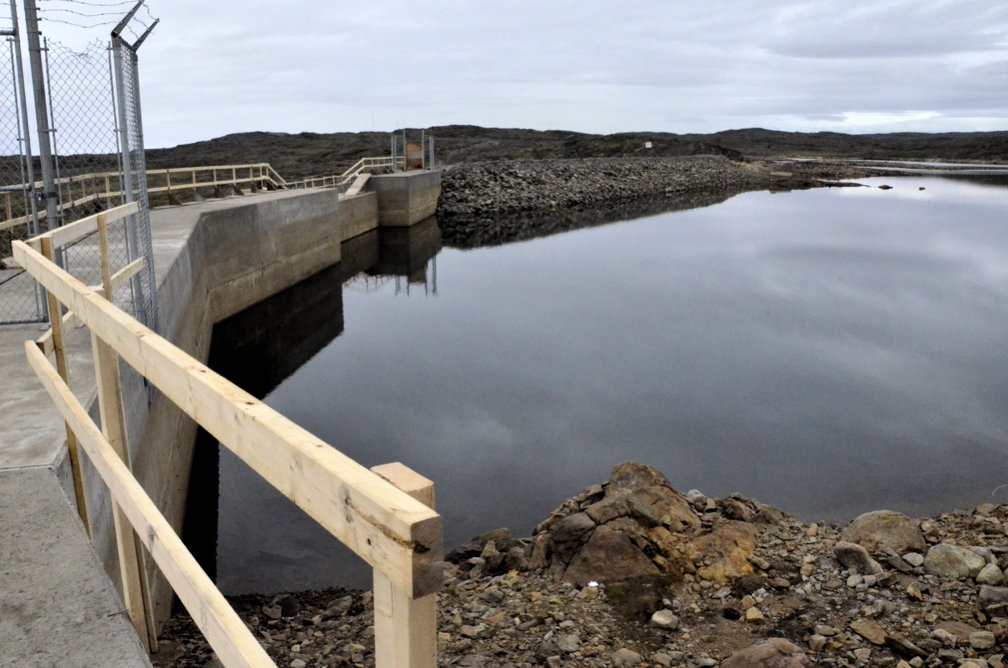Iqaluit seeks a new emergency fix for another looming water shortage
Record low rainfall means the Nunavut capital's water supply is at its lowest levels ever.

To ensure Iqaluit’s Lake Geraldine water reservoir contains enough water to make it through the winter, Iqaluit municipal officials want the Nunavut Water Board’s permission to start pumping water as soon as possible from a nearby body of water they call Unnamed Lake.
That’s because — due to record low rainfall and snowfall in 2019 — the volume of water at Lake Geraldine is at its lowest level ever for this time of year, Matthew Hamp, the city’s director of engineering and public works, told reporters at the beginning of August.
“In 2019, Iqaluit has experienced the lowest precipitation in recorded history and will thus not be able to refill the reservoir solely from Apex River,” a city fact sheet says.
Flow rates for rivers around Iqaluit are also at record low levels due to low precipitation.
To mitigate that, the city wants, by Aug. 15, to pump as much as 700,000 cubic meters of water from Unnamed Lake into the Apex River and from there into Lake Geraldine.
To that end, the city went to the water board this past July 10 and filed an application for an emergency water licence amendment to pump water from Apex River.
Then they replaced that application on July 31 with a proposal to also pump from Unnamed Lake.
Nunavut minister declares state of emergency
To back the city’s application, Lorne Kusugak, the Nunavut minister of community and government services, on sent the water board a letter July 31 that declares a state of emergency under the Emergency Measures Act.
“Access to clean water is critical to human health, and it is the interest of ensuring the health and safety of Iqalummiut that the project be carried out without delay,” Kusugak said.
Designating the situation as an emergency will help the city avoid a protracted regulatory process and ensure they get a rapid decision from the water board.
That’s important, because the city needs to ensure Lake Geraldine is filled to capacity before ice begins to form this fall.
Lake Geraldine stops accumulating water after freeze-up, usually around mid-October, and can’t be replenished until after the spring melt brings fresh runoff water into the reservoir.
This time, city must pump more water
And to do that, they need a lot more water than they needed this time last year, when the city pursued a similar kind of one-time-only emergency water amendment that allowed them to pump extra water from the Apex River, Hamp said.
In August 2018, the city needed about 400,000 cubic meters of water to top up the reservoir, Hamp said.
The city, however, caught a break. Because of high rainfall in September, the city needed only about 200,000 cubic meters of water from the Apex River to restore Lake Geraldine to a safe level last year.
But this year, Lake Geraldine likely needs as much as 700,000 cubic meters more to make it through until spring, Hamp said.
Unnamed Lake is located northeast of Lake Geraldine, about three kilometers from a pumping station site on the Apex River off the Road to Nowhere.
The city chose Unnamed Lake after consulting elders and member of the hunters and trappers organization, Hamp said.
The city has already dropped off pipes at a pumping station site on the Apex River, and will fly needed equipment by helicopter to Unnamed Lake, Hamp said.
Once work starts on the emergency project, it will likely take eight weeks to transfer enough water from Unnamed Lake into Apex River and on to Lake Geraldine, the city says.
Longer-term water licence process continues
Meanwhile, a longer-term water licence amendment application that Iqaluit filed with the water board earlier this year is still with the regulatory system.
Under that application, the city seeks permission to pump 500,000 cubic meters of water from Apex River into Lake Geraldine every year from now until 2026.
It also asks that the amount of water that Iqaluit is legally allowed to withdraw from Lake Geraldine be increased from 1.1 million cubic meters per year to 2 million cubic meters per year.
The Nunavut Impact Review Board, in a screening decision, has already concluded that that proposal is not likely to cause significant public concern, and is unlikely to result in significant adverse environmental and social effects.
The plan is now in the hands of the Nunavut Water Board, which held public hearings on the proposal last week.
You can find information on the application at the water board’s FTP-based public registry here.
And you can find information on this year’s emergency water license amendment here.
As for the future, city officials say it’s likely that from now on, they’ll have to pump water from Apex River every year.
“If we get really good run-off in a couple of years, we might not have to, but we’re anticipating that we should be prepared to do this every year,” Hamp said.
And for the future, beyond 2026, the city, because of continued growth, will likely have to look at new permanent solutions to its water supply problems, including pumping water from either Sylvia Grinnell River or Unnamed Lake, and expanding the holding capacity of Lake Geraldine, Hamp said.